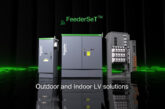
Scolmore Group looks at the ever-changing regulations regarding SPDs and ponders what the future might hold for domestic usage.
BS 7671 is due for a second amendment this year and we currently understand SPDs are due for review. It’s proposed the current regulations are changed to simplify the process a designer completes to identify if SPDs are needed. With this in mind, let’s take a deeper look at SPDs and try to understand where the industry is heading.
Surge Protection Devices
There are instances where a transient overvoltage is generated, and such overvoltages can be created from a variety of sources including:
● a lightning stroke close to overhead power lines generating an induced current within the conductors.
● a lightning stroke making contact with the general mass of Earth close to underground cables, thereby generating an induced current within the underground cable conductors.
● induced emf within conductors caused by the switching of highly inductive loads.
What is an SPD?
Taken simply, an SPD is a special kind of device which protects electrical equipment, wiring, and accessories from electrical power surges by shunting current to Earth within milliseconds. To do this, SPDs typically make use of two technologies:
a) spark gap
b) varistors
SPDs make use of spark gap technology to detect a transient overvoltage and start the discharge process. The generated arc is then channelled into an arcing chamber which allows the arc to be split up into several small partial arcs. This type of technology is typically found in Type 1 SPDs. SPDs also make use of the qualities of a varistor (voltage-dependent resistor). Varistors have a high impedance under normal operating conditions; however, when a transient voltage appears its resistance reduces, causing excess current to ‘shunt’ to Earth. When the transient overvoltage is removed the device returns to its typical high impedance state.
There are three ‘Types’ of SPD classified according to their standard:
Type 1 – typically installed at the origin of the installation and usually operate on ‘spark gap’ technology.
Type 2 – typically installed at distribution boards and operate on varistor technology.
Type 3 – typically installed local to connected equipment.
Reason for their introduction
It has taken some time for SPDs to become common within the UK. The initial reluctance of the contracting industry in installing SPDs was due to the perceived relatively low level of risk of transient overvoltages due to lightning strokes and the limited likelihood of damage to connected equipment. However, it has been commonly accepted that with the increase in the cost of equipment and appliances installed the impetus for the use of SPDs has, correspondingly, increased. An installation protected by suitably selected and erected SPDs will be able to limit the risk of damage to connected equipment caused by a transient overvoltage, potentially saving thousands of pounds. Based on the draft for public comment (DPC), there are two conditions where SPDs will be required:
a) where there is a risk of serious injury to, or loss of, human life, for example a safety service.
b) where there is significant financial or data loss.
In all other instances Regulation 443.4.1 recognises that protection against transient overvoltages using devices such as SPDs, is reasonable, unless the owner of the installation declares it is not required due to any loss or damage being acceptable.
BS 7671
There are a significant number of regulations detailed within BS 7671 regarding SPDs. Other than the general requirement for overvoltage protection in Regulation 443.4.1, Section 534 (along with the informative Appendix 16) details the specific requirements for the designer and installer to consider when specifying SPDs.
Regulations 534.4.1.1 details the locations where SPDs are required. Type 1 or Type 2 SPDs should be installed at the origin of an electrical installation, while Type 2 or Type 3 SPDs installed downstream of the origin further protect against switching transients originating within the building. It is permitted for SPDs to have combined classification, for example, a combined Type 1+2 or a combined Type 2+3 (Regulation 534.1). The note to Regulation 534.4.1.1 states that Type 1 SPDs are often referred to as ‘equipotential bonding SPDs’ and are fitted to the origin of the installation to prevent dangerous sparking which might lead to a fire or shock hazard.
It should be carefully noted that BS EN 62305-4 recognises that a Type 1 SPD will not provide effective protection against the failure of sensitive electrical and electronic systems and that subsequent Type 2 and Type 3 devices will be needed downstream of the origin. The designer also needs to determine whether the SPD has internal overcurrent protection, otherwise there will need to be overcurrent protection with respect to short-circuit currents (Regulation 534.4.5.1). Should the overcurrent protective device operate the installation will continue to operate but will not be protected against subsequent transient overvoltages.
A familiar sight
SPDs will be a much more common feature within electrical installations and contractors will need to be familiar with the Type, application and protection necessary. It is believed that the second amendment to BS 7671 will see stronger support for the use of SPDs in more installations, including safety services. If this is the case and the proposed change is included in the final document, SPDs may be needed in all domestic properties. Scolmore will be looking to see if this change comes about and mandates the use of SPDs in domestic installations for the first time.
To browse the Elucian Circuit Protection catalogue click here










